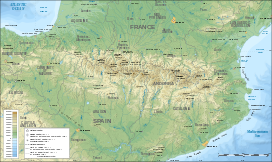Mallos de Riglos
- View a machine-translated version of the Spanish article.
- Machine translation, like DeepL or Google Translate, is a useful starting point for translations, but translators must revise errors as necessary and confirm that the translation is accurate, rather than simply copy-pasting machine-translated text into the English Wikipedia.
- Do not translate text that appears unreliable or low-quality. If possible, verify the text with references provided in the foreign-language article.
- You must provide copyright attribution in the edit summary accompanying your translation by providing an interlanguage link to the source of your translation. A model attribution edit summary is
Content in this edit is translated from the existing Spanish Wikipedia article at [[:es:Mallos de Riglos]]; see its history for attribution. - You may also add the template
{{Translated|es|Mallos de Riglos}}to the talk page. - For more guidance, see Wikipedia:Translation.


The Mallos de Riglos (English: Mallets of Riglos)[1] are a set of conglomerate rock formations, located in the municipality of Las Peñas de Riglos, in the Hoya de Huesca comarca, in Aragon, Spain. They are located near Las Peñas de Riglos some 45 km (28 mi) to the northwest of the city of Huesca. Rising to some 300 metres (980 ft) high (c. 1000 metres or 3,300 ft (1,000 m) above sea level), they form part of the foothills of the Pyrenees.[1]
The Mallos were formed when eroded material washed down from the slopes of the Pyrenees and became cemented together by limestone. Over time, this mixture became compacted into a large mass of conglomerate rock.[1] Eventually, erosion wore away the softer, more porous parts of the conglomerate. The more resistant rock remained, and became the formations known as the Mallos de Riglos.[1]
Because of their relatively vertical sides, the Mallos de Riglos are a popular destination for climbers.
Gallery
References
- ^ a b c d Scheffel, Richard L.; Wernet, Susan J., eds. (1980). Natural Wonders of the World. United States of America: Reader's Digest Association, Inc. p. 318. ISBN 0-89577-087-3.
External links

- Visitor information from InfoAragón
- Satellite view of the Mallos de Riglos from Google Maps
- Rock-climbing guide to Riglos
- Illustrated article on climbing at Riglos
- v
- t
- e












